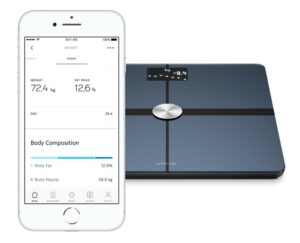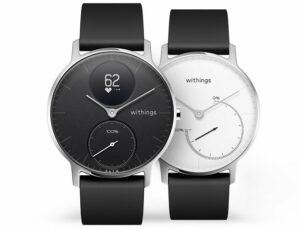How to Lose Weight
Every time you pick up your phone or flip on the TV, you see a new diet, workout, or routine that promises to help you drop extra weight. So, how do you know where to start?
Start here! This guide gives you five behaviors that will help you lose weight with (or without) phentermine, plus maintain a healthier weight long-term.
1. Weigh Daily

If you’re chasing a weight-related goal, it’s important to measure and track how much you weigh over time.
Research shows that daily, or at least frequent, weigh-ins are an important habit for weight loss and maintenance (
 Smart scales like those by Withings take the work out of tracking and make it easier to see your overall weight trend. Scales like Withings Body, Body+, and Body Cardio will also track body mass index (BMI), body fat percentage, and even heart health – all synced into an app on your phone.
Smart scales like those by Withings take the work out of tracking and make it easier to see your overall weight trend. Scales like Withings Body, Body+, and Body Cardio will also track body mass index (BMI), body fat percentage, and even heart health – all synced into an app on your phone.
All of these functionalities make a smart scale an invaluable tool for your weight loss journey, no matter whether you love checking the numbers daily or letting the app do all of the tracking for you.
2. Eat Nutritiously

Once you’ve measured your starting weight and thought about goals, diet is the next step. What you eat is the most important determinant of weight loss and weight maintenance.
Each day eat 500 calories less than normal to lose one pound per week, or 1000 calories less than normal to lose two pounds per week. At its most basic, each pound of fat is equivalent to 3500 calories of energy. That means that eating 500 calories less per day for 7 days forces your body to burn off about one pound of fat for fuel (
However, it’s not just the quantity that matters. Quality matters, too. Make half your plate full of non-starchy fruits and veggies, one-quarter of lean protein, and one-quarter of whole grains. Use healthy fats to prepare and complement your food (
TIP: It’s deceptively easy to eat a few hundred calories but much harder to burn off those extra calories with exercise. Pay attention to portion sizes.
3. Exercise Regularly

Exercise is great for your health, and not just because it burns additional calories. People who exercise regularly have stronger immune systems, more energy, better heart health and less anxiety (
Experts recommend 150 minutes per week of vigorous exercise – or 300 minutes of moderate exercise – plus two days of strength training (
Do 30-60 minutes per day seem a bit unattainable at the moment? Don’t worry: research shows that short bursts of activity promote health and weight loss as well (
 Wearing an activity tracker, like Withings Move, can help you keep track of your steps and minimize sedentary minutes each day. Many smartwatches even notify you when you’ve been sitting too long to remind you to get up and move.
Wearing an activity tracker, like Withings Move, can help you keep track of your steps and minimize sedentary minutes each day. Many smartwatches even notify you when you’ve been sitting too long to remind you to get up and move.
A watch that tracks and encourages your fitness goals promotes not only weight loss, but also overall health.
4. Reduce Stress

You’re putting in the effort to eat right and stay active, so don’t forget about stress management.
Chronic stress has been shown to slow metabolism, increase cravings for salty, high-fat food and cause fat to accumulate around the stomach (
Thankfully, taking just one minute to control your breathing can significantly reduce tension and stress.
Close your eyes and breathe in through your nose for 4 seconds, hold for three seconds, and then exhale slowly for one second. Repeat four times and feel the stress slide away.
Watches that track your heart rate, such as the Steel HR, are also an immense help with this because they monitor your stress and let you know when you most need to take a moment to relax.
5. Consider a Boost

If you’ve tried the lifestyle changes above and still aren’t seeing the weight loss you’re looking for, consider another medication or a supplement to boost weight loss.
Phentermine is one option. It is a prescription-only appetite suppressant that can only be taken for a short period of time, but these pills have helped millions of patients around the world reach their weight loss goals.
While taking phentermine, always take your medication exactly as prescribed and follow doctors’ orders about diet and exercise.
If you aren’t interested in prescription-strength diet pills, consider PhenQ. This all-natural dietary supplement suppresses appetite and boosts energy to help you reach your weight loss goals faster.
- Pacanowski, C. R., & Levitsky, D. A. (2015). Frequent Self-Weighing and Visual Feedback for Weight Loss in Overweight Adults. Journal of Obesity, 2015, 1–9. doi: 10.1155/2015/763680
- Family Health Team. (2018, December 26). How Often Should You Step on the Scale?
- Mayo Clinic Team. (2018, March 28). The best ways to cut calories from your diet.
- US Department of Agriculture. (2020). ChooseMyPlate.
- S. National Library of Medicine. (2019, October 4). Benefits of Exercise.
- Cassity, J. (n.d.). 7 Hidden Benefits of Exercise.
- Office of Disease Prevention and Health Promotion. (09-2019). Physical Activity Guidelines for Americans.
- Harvard Health Publishing. (2019, May). Do short bursts of exercise help?
- Diaz, K. M., Howard, V. J., Hutto, B., Colabianchi, N., Vena, J. E., Safford, M. M., … Hooker, S. P. (2017). Patterns of Sedentary Behavior and Mortality in U.S. Middle-Aged and Older Adults. Annals of Internal Medicine, 167(7), 465. DOI: 10.7326/m17-0212
- Kiecolt-Glaser, J. K., Habash, D. L., Fagundes, C. P., Andridge, R., Peng, J., Malarkey, W. B., & Belury, M. A. (2015). Daily Stressors, Past Depression, and Metabolic Responses to High-Fat Meals: A Novel Path to Obesity. Biological Psychiatry, 77(7), 653–660. DOI: 10.1016/j.biopsych.2014.05.018
- Moyer, A. E., Rodin, J., Grilo, C. M., Cummings, N., Larson, L. M., & Rebuffé-Scrive, M. (1994). Stress-Induced Cortisol Response and Fat Distribution in Women. Obesity Research, 2(3), 255–262. DOI: 10.1002/j.1550-8528.1994.tb00055.x
[phen_toc]
[phen_toc]
[phen_toc]

